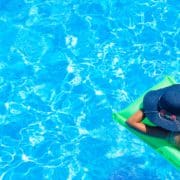9 Tips for Opening Your Pool
Spring is here, and it’s time for some pool opening tips!
If you’re ready to open your pool, you’re in the right place. We always recommend opening early and closing late for the best water all season long.
To help you, take a look at these nine pool opening tips:
Get Organized
The first thing you want to do is make a list of everything you need. This includes any chemicals, equipment and tools.
Check for broken equipment and leaks.
If you have a heater, and you want to use it this spring, be sure and check it out.
Test the heater as well as your other pool equipment. As you test equipment, let it run for a good half hour to make sure everything is working properly, and nothing is leaking or needs service.
Be sure to check the expiration date on your chemicals as well.
Then, decide if you’ll open your pool or hire a professional to do it.
#1: Peek Under the Cover
It’s a good idea to take a look under your cover a week or two before you open your pool.
Add some additional chlorine. This will assist you with any water chemistry problems you might be experiencing while help to prepare your pool for opening.
#2: Clean Your Cover
You want to clean your cover before you take it off so debris doesn’t fall into the pool. Get as much water off it before you remove it as possible. You don’t want the dirty water in the pool either.
Consider a pump to help you remove rainwater.
Once you’ve removed the cover, it’s time to really clean it. Lay it out in an open space, sweep off any remaining debris, and use a cover cleaner to wipe away dirt and grime. Then, spray it with your hose.
Let your cover dry completely before putting it away for storage to prevent mildew from forming. Store it in a dry place, free of debris and protected from the sun and the weather. Be sure it is off the floor so bugs and rodents can’t get inside.
#3: Check Your Water
Your first step is to turn off the skimmer, open the main drains and point the return jets down.
Set your pump to run continuously on the highest speed until your water is clear.
You can add some shock and algaecide and brush the sides of your pool.
#4: Check Your Pump, Skimmer Basket, and Filter
You’re looking for any damage and debris when checking these items.
- Inspect the pump lid and O-ring for cracks or damage.
- Lubricate the O-ring if needed.
- Clean the pump basket by removing debris and rinsing it thoroughly.
- Check the skimmer basket and filter, ensuring they are free of debris.
- Make sure your filter is clean or the sand is in good shape if you have a sand filter.
#5: Add Water
Your pool has probably lost water, so you want to fill it up.
It’s a good idea to fill it up with your hose while you’re removing water from the top of your pool cover before removing it.
Don’t leave it unattended, as you don’t want the siphon to remove the water from your pool in addition to your pool cover.
Please note: your pool should be filled to the middle of the skimmer opening to allow for proper circulation.
#6: Circulate the Water
Before you test your water and add products, ensure it’s been circulating for 24 hours.
Remember, your pool has been covered for several months, and what’s on the bottom of the pool may not be the same as what’s on the top.
#7: Have Your Water Tested
Be sure to circulate pool water 24 to 48 hours before taking a water sample. Use a clean plastic container and scoop about one quart of water from elbow depth (away from skimmers and returns). Seal the container and bring it to us for free testing and analysis.
With ALEX, our computerized water analysis system, you get accurate results almost instantly. You will receive personalized step-by-step instructions for starting your pool.
8. Test Sanitizer and pH
You can test sanitizer and pH yourself using BioGuard Test Strips to check free chlorine, total bromine residuals, pH levels, and Total Alkalinity. Use the following list to determine the proper levels.
- Free Chlorine residual: 1.0 to 4.0 ppm
- Total Bromine residual: 1.0 to 4.0 ppm
- pH: 7.4 to 7.6 is the ideal range (7.2-7.6 is acceptable)
- Total Alkalinity: 125 to 150 ppm (or 80 to 150 ppm for saltwater pools)
- Calcium Hardness (plaster and SoftSwim® pools): 200 to 275 ppm
- Calcium Hardness (all other types): 175 to 225 ppm
Don’t forget to practice routine maintenance, as this is the best way to maintain your pool.
#9: Practice Safety
A final thing to think about is the safety of your pool.
Inspect your pool barriers and ensure that they can protect children and pets from drowning.
Do everything you can to create barriers to unauthorized access to your pool – think neighborhood children or wandering pets. Ask yourself if someone can climb over your fence or use a tree for leverage. Look for holes in your fence, too.
Take a look at your backyard pool from your own children’s vantage point as well, and make sure they are safe.
Final Pool Opening Tips
If you’re ready to open your pool, follow these steps for a more effortless opening. If you’d like some help, please contact our service department today for an easy opening.
We proudly carry BioGuard products!
















